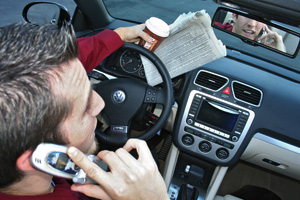Distracted driving is any activity that could divert a person’s attention away from the primary task of driving. All distractions endanger driver, passenger, and bystander safety.
These types of distractions include:
- Texting
- Using a cell phone or smartphone
- Eating and drinking
- Talking to passengers
- Grooming
- Reading, including maps
- Using a navigation system
- Watching a video
- Adjusting a radio, CD player, or MP3 player
But, because text messaging requires visual, manual, and cognitive attention from the driver, it is by far the most alarming distraction.The best way to end distracted driving is to educate all Americans about the danger it poses. On this page, you’ll find facts and statistics that are powerfully persuasive. If you don’t already think distracted driving is a safety problem, please take a moment to learn more. And, as with everything on Distraction.gov, please share these facts with others. Together, we can help save lives.
Got questions? Look at sample research reports.
Key Facts and Statistics
In 2011, 3,331 people were killed in crashes involving a distracted driver, compared to 3,267 in 2010. An additional, 387,000 people were injured in motor vehicle crashes involving a distracted driver, compared to 416,000 injured in 2010.
18% of injury crashes in 2010 were reported as distraction-affected crashes.
In the month of June 2011, more than 196 billion text messages were sent or received in the US, up nearly 50% from June 2009. (CTIA)
11% of all drivers under the age of 20 involved in fatal crashes were reported as distracted at the time of the crash. This age group has the largest proportion of drivers who were distracted.
40% of all American teens say they have been in a car when the driver used a cell phone in a way that put people in danger. (Pew)
Drivers who use hand-held devices are 4 times more likely to get into crashes serious enough to injure themselves. ( HYPERLINK “http://www.distraction.gov/research/PDF-Files/Effects-of-Text-Messaging.pdf”Monash HYPERLINK “http://www.distraction.gov/research/PDF-Files/Effects-of-Text-Messaging.pdf” University)
Text messaging creates a crash risk 23 times worse than driving while not distracted. (VTTI)
Sending or receiving a text takes a driver’s eyes from the road for an average of 4.6 seconds, the equivalent-at 55 mph-of driving the length of an entire football field, blind. (VTTI)
Headset cell phone use is not substantially safer than hand-held use. (VTTI)
Driving while using a cell phone reduces the amount of brain activity associated with driving by 37%. (Carnegie Mellon) NHTSA



